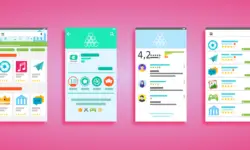Last updated on September 28th, 2022 at 04:15 pm
For a long time, marketers have been leveraging Emails and SMS to do what push notifications are doing today. Though Push Notifications will never replace emails, there is little doubt about the impending days of SMS for marketing.
If we talk about push notifications, they are a small chunk of texts organized on a clickable interface to direct a user to a specific web URL or app page.
We can use a push message for marketing and utility communication through websites and mobile apps, depending on the content.
Here, this article focuses on the notifications sent by websites to their subscribers for marketing purposes.
By using the term “Subscribers,” I would like to clarify that–
- Websites can only send web push notifications
- Websites can send alerts to only ‘subscribed’ users
- Users need to first opt-in to become subscribed users
How do Websites Use Browser Push Notifications for Marketing?
Websites use web or browser push notifications to convey both transactional and marketing communications. Transactional communications focus on conveying important information such as:
- A transaction update, e.g., order confirmation
- A confirmation alert, e.g., package delivery update, flight departure schedule
- A direct action request, e.g., link verification request
There are many ways to use web push notifications for promotion with marketing and user engagement aims like:
- Boosting user engagement
- Promoting new products or services
- Calling an inactive user back on the site
With all these promotional aims, a website can create engagement web push content conveying information such as:
- Flash sale alert
- Discount coupon codes
- Drop in the price alert
- News Flash
- New products uploaded
- New videos uploaded
- New blog posted
Transactional alerts aim at conveying a piece of important information, whereas engagement notifications convey not only a piece of information but also encourage action from the user.
These actions might include:
- Getting the users to visit the website
- Getting a sales conversion from the user
- Getting the users to read the blog content posted
- Following the user to subscribe to a service
- And many more actions that bring business directly or indirectly
Related: Seven Marketing Techniques For Small Businesses (That Yield Results Quickly)
How Websites Integrate Web Push Notifications?
How do websites use email and SMS marketing? By integrating software, a solution, or a tool that allows them to automate emails and SMS based on different user actions on the site. Businesses subscribe to various SMS marketing channels and email marketing tools (like MailChimp) to send bulk communications.
In the same way, there are different push marketing channels, web push notification services, and tools used for sending these clickable messages to subscribers.
Businesses integrate different software solutions to automate the process and send bulk messages in one go. Like every service in the market, companies pay charges and rentals to use these tools and push message services.
Some examples of web push notifications services and tools in the market are as follows-
- Google’s Firebase Cloud Messaging: Free
- Amazon AWS: Subscription billing
- PushMaze: Onetime buying cost
- Push Crew: Subscription billing
- Push Engage: Subscription billing
Are Web Push Notifications Any Effective Than Other Channels?
Email and SMS have helped marketers since digital marketing was introduced to humanity. However, the current competitive scenario has constructively forced marketers to experiment with new ways of getting an edge over rival businesses. Web push alerts are one such edge and the latest internet marketing channel.
In a short time, they have gained immense popularity among marketing professionals and disentangled many drawbacks we used to see in the other two channels. We are gradually experiencing a shift in trend from SMS and Email Marketing towards Push Marketing.
There is a catch,
You cannot rely on push alerts to convey all types of information. For example, you cannot send files with them. As a result, I cannot send resources like invoices through them. Users cannot save these alerts for future reference too. They serve better such information with emails and SMS only.
Push notifications have a few additional weaknesses that make them not a suitable replacement for traditional marketing channels (Email and SMS).
Seen as Ads by Users
People hate those pop-up ads that interrupt their regular browsing experiences. Just like an intrusion to their regular activity. In the same way, when push are shown to the users as pop-ups. As a result, users mistake these alerts for Ads and simply ignore them.
About 48% of users don’t find push alerts useful to them.
Just Pile up in the Notification Board
Today, almost every website and mobile app are using push. It would be safe to say that a push message from one app or website every other minute irritates the users. As a result, users block all the alerts in one go. Push notifications can do well when marketers know how many messages to send and in what frequency.
Work only with Pre-built Loyalty of Users:
You cannot just push notifications to all your website visitors. It can be sent only to subscribed users. Hence, it is required that users already know of your business and are interested in it. That means new users who just visited your site would hardly opt in after the first interaction.
It Involves the Additional Setup Cost:
You need a push notification service or tool to send the alerts. Integrating these tools into your website involves costs for development, deployment, maintenance, and subscription. These are expensive for many small businesses. For example, a typical push message service will cost you around $150/1000 notifications.
A positive side of Web push notifications
Despite some downsides, web push notifications have a specific strength that makes them necessary. My strong opinions are on integrating a push notification tool parallel to email and SMS marketing campaigns. The catch is that if you don’t, your rivals will use them to get an edge over you.
Here are a few reasons advocating the need for push marketing of your website.
Traceable analytics
Almost every push marketing tool in the market offers built-in analytics to measure the metrics like open rate, read time, segmentation, delivery rate, and conversion rate. Compared to SMS and Emails, it is accessible to trace and test your push campaigns. With push, you can always analyze your efforts against the ROI.
Cost-effective Options Are Also There
Most of the tools and services in the market are expensive for startups. However, many other tools can give you a cheaper startup kit. For example, self-hosted push notification tools come with a one-time buying cost. They don’t charge for sending notifications. They are open-source, and you can own the tool and customize it yourself.
Time-saving with full Automation
You can save a lot of your time by fully automating the notifications. Through geo-fencing, you can set up behavior-based messages, Event-based notifications, and location-based alerts. Not just that, you can also automate the notifications by segmenting factors like Age, Gender, Time-zone, etc.
For example, you can set up an abandoned cart push alert follow-up. A follow-up message will be sent automatically when a user leaves your eCommerce shopping cart, asking the user to complete the checkout process.
Real-time Tracking
Event-based automated alerts can track the users in real time. You can interact with your users without manual intervention based on the set triggers and templates. Such setups assist a business in reaching its target audience at the right time, place, and precise information.
Related: Key Metrics Every Modern Marketer Should Know About
No Email or Contact Number Required
You don’t need a user’s email address or contact number to send them a web push message. Your visitors can subscribe to your push alerts sharing no such information. That means you can reach your audience with no contact address.
Increased Customer Engagement and No Spam Filters
Ultimately, push alerts receive much improved opt-in, click-through, and conversion rates. Experts believe users’ response to push messages is ten times better than emails or SMS. They don’t have to use spam filters to reach the user’s notification board. As a result, almost every notification is delivered to the users and thus receives a better engagement stat.
Related: Why Customer Loyalty Is Important (And How To Build It)
No Mobile App Required
The best thing about web push notifications is you don’t need a mobile app to use this channel. You can reach your audience on mobile and desktop devices through web browsers. That means they save the cost of developing a mobile app for using the power of push notifications.
Conclusion
Push notifications are still new to marketers. Let’s not overlook it is not yet a full-fledged marketing tool. There is quite a scope for improvement in its application to marketing tactics. While some have established mastery over push marketing, there are still professionals who lack the skill of using them correctly. However, it also does not mean that you should not use them. Be advised that your rivals are already using them and getting some handsome returns.
About Author:
Marry Ann is a branding consultant for PushMaze, a service that lets you send trackable push notifications to users. She is mainly passionate about building brands in all aspects of online marketing. Reach her: Twitter | LinkedIn
Additional Resources:



